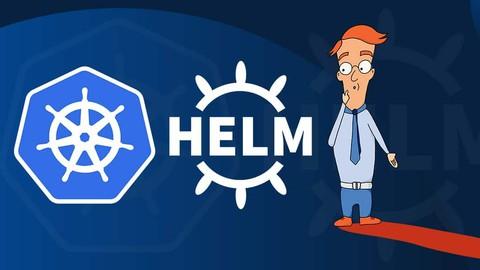Last Updated on March 4, 2025 by GeeksGod
Course : HELM MasterClass: Kubernetes Packaging Manager
Kubernetes Packaging: Mastering Helm for Effective Deployment
If you’re diving into the world of Kubernetes, chances are you’ve heard of Helm. Think of it as the friendly delivery service that helps you package and distribute your applications in the Kubernetes ecosystem. So, what makes Kubernetes packaging so essential and how can mastering Helm elevate your cloud game? Let’s break it down.
What is Kubernetes Packaging?
Kubernetes packaging refers to the way applications are encapsulated for deployment in a Kubernetes cluster. With microservices architecture on the rise, the need for efficient management and release of software is pivotal. Here’s where Helm kicks in as a brilliant solution.
Why Use Helm as Your Kubernetes Packaging Manager?
Helm is an open-source tool that simplifies the deployment process in Kubernetes. Here are some reasons why you should consider using Helm:
- Easier Deployments: Helm allows you to manage your Kubernetes applications with simple commands.
- Version Control: With Helm, you can rollback to previous versions effortlessly.
- Reusable Packages: You can create reusable charts that can be shared across projects.
- Community Support: A vibrant community contributes to Helm, ensuring it’s up-to-date and reliable.
Have you ever tried deploying an application in Kubernetes manually? It can be overwhelming with all the configurations involved. Helm makes this less of a headache and more enjoyable.
Getting Started with Helm for Kubernetes Packaging
In this free Udemy course on Kubernetes Packaging, you will learn everything from basic commands to advanced functionalities of Helm. Here’s a sneak peek into what to expect:
Simple Commands to Get You Going
This course will guide you through the core Helm commands. You will learn how to:
- Add repositories with
helm repo add - Install applications with
helm install - Upgrade existing releases using
helm upgrade
Mastering these commands is like learning the alphabet before writing a novel; they form the foundation for effective Kubernetes packaging.
The Release Process Unveiled
Understanding the release process is crucial for successful deployments. In this course, you’ll discover:
- The workflow of a Helm release
- How to check release history with
helm history - How to perform rollbacks with
helm rollback
Imagine you’re debugging your app and something goes wrong. With Helm, you can simply revert to a stable state in seconds, much like hitting the rewind button on a remote control.
Advanced Concepts in Kubernetes Packaging
Once you’re comfortable with the basics, it’s time to dive deeper. The course will cover more advanced Helm commands and concepts, including:
- Atomic installations
- Creating your own charts
- Understanding the Helm templating syntax
These advanced features turn Helm into a powerful tool. For instance, the ability to create charts allows you to define your application’s structure and dependencies efficiently, leading to cleaner deployments.
Building Your Own Charts
Understanding the Chart Structure
A Helm chart is essentially a packaged application. You’ll learn about the folder structure and necessary files required to create a Helm chart. This knowledge is invaluable for Kubernetes packaging.
Templating Magic
One of the coolest features of Helm is its templating engine. You’ll discover how to:
- Use functions and conditional statements
- Run chart tests
- Secure your charts using signatures and hashes
Creating your own charts can be likened to building your own Lego set; you have the pieces, and you decide how to put them together for the best outcome.
Practical Use Case: Deploying a Microservice
What better way to solidify your learning than through practical application? The course includes a hands-on use case where you’ll deploy a microservice to Kubernetes using Helm within minutes. You’ll learn:
- How to structure your application for Kubernetes
- To package and deploy quickly
- To make use of the best practices in Kubernetes packaging
Who Should Take This Course?
This course is perfect for:
- Beginners: If you are new to Kubernetes, this course will help you understand the nuances of Helm as your Kubernetes packaging manager.
- Experienced Developers: Even seasoned developers will benefit from mastering the fundamentals and uncovering advanced features.
Add “Kubernetes Packaging” and Helm expertise to your resume, and you’ll certainly see more job opportunities and potentially better salary negotiations!
Frequently Asked Questions
What is Helm?
Helm is a package manager for Kubernetes that helps you define, install, and upgrade applications in a Kubernetes cluster.
What are Helm charts?
Helm charts are packages of pre-configured Kubernetes resources that help manage applications.
Is Helm easy to learn?
Yes, Helm is designed to simplify application management, making it approachable for both beginners and experienced developers.
Can I use Helm for any Kubernetes application?
Most applications can be packaged and managed using Helm, making it a versatile tool.
What is the best way to learn Helm?
The best way to learn is through practical experience—taking a course or tutorial that includes hands-on exercises like the one offered on Udemy.
Conclusion: Your Journey into Kubernetes Packaging
Mastering Kubernetes packaging through Helm opens a world of opportunities in managing applications efficiently in a cloud-native environment. With the hands-on experience you’ll gain, you can elevate your skills and transform your deployment processes. Ready to get started on this journey? The insights you’ll gain from the free Udemy course on Kubernetes packaging will serve as a strong foundation for your career in DevOps.














